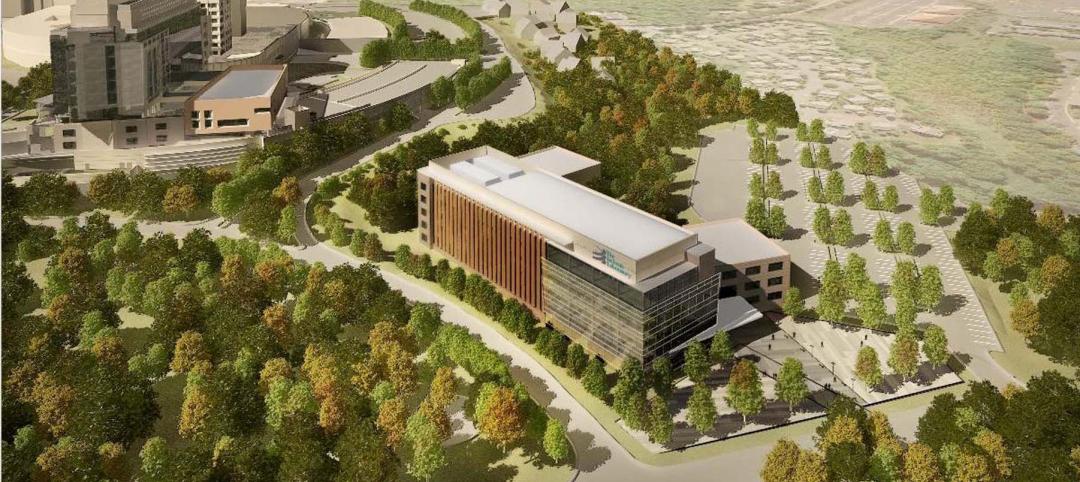Rochester, Minn., home to the famed Mayo Clinic, is about to embark on what would be the largest economic development initiative in this state’s history.
The state government, the Mayo Clinic, and private investment partners are prepared to spend $6.5 billion on a 20-year plan whose goal is to elevate Rochester into a global biotech hub. The plan is also intended to rejuvenate Rochester’s downtown, promote open transit, and reconnect the city with its waterfront.
On April 23, the Board of Directors of the Destination Medical Center Corporation formally adopted the development plan for Destination Medical Center (DMC), which would be comprised of six districts spread across 550 acres. The vertical construction would support a diverse mixed-use environment that complements Mayo’s existing facilities, which already provide care for one million patients annually.
The state government, the Mayo Clinic, and private investment partners are prepared to spend $6.5 billion on a 20-year plan whose goal is to elevate Rochester into a global biotech hub. The plan is also intended to rejuvenate Rochester’s downtown, promote open transit, and reconnect the city with its waterfront.
The six districts identified in the development plan include:
• The Heart of the City: The plan would convert the downtown area into a place of “connected urban experiences” that build off of the city’s existing walkable attributes, with enhanced areas and mixed-use buildings
• Discovery Square: Steps from Mayo Medical School, this would be the address for the expansion of science, research, tech, and entrepreneurism;
• Downtown Waterfront: This would be located where the Zumbro River and Second Street intersect. It would be a cultural and historical center, and provide live-work opportunities;
• Central Station: A nexus of transportation for the downtown area, with an intermodal transit station that is incorporated into mixed-use development;
• UMR and Recreation Area: On the south edge of downtown, this location would encompass the University of Minnesota-Rochester campus and Soldier’s Memorial Field; and
• St. Mary’s Place: A new public space in the downtown’s western corner.
Peter Cavaluzzi, FAIA, Principal and Board Member for Perkins Eastman, this project’s lead designer, thinks The Heart of the City will be the most critical component, and have the biggest impact, early on. “The first phase of every large-scale project has to be bold enough to have an impact, but at the same time be small enough that it can be achieved.”
Perkins Eastman says the initial phase will start at the city’s 1st Street and 1st Avenue, in the middle of Peace Plaza, where a grand dining terrace will span the Avenue and connect to the historic Chateau Theater.
A breakdown of Destination Medical Center shows that it would have 6.8 million sf of healthcare facilities, 1.02 million sf of biotech, 310,000 sf of offices, a 1,380-room hotel, 2,850 units of residential, 354,000 sf of educational space, and 117,000 sf of transit, which would include 22,850 new parking spaces. Fast Company reports that there is also a possibility of a rail link between Rochester and Minneapolis, 90 miles away.
Rochester officials see this project as a way for their city to get out from under the shadow cast by the Minneapolis-St. Paul metroplex. DMC could also give Mayo Clinic a leg up on other healthcase hubs like Cleveland Clinic and Johns Hopkins that are all vying for what’s known as medical “tourists,” affluent foreign patients seeking the best treatment available.
Lisa Clarke, DMC’s executive director, estimates that this development would create between 25,000 and 40,000 jobs over 20 years, plus significantly more tax revenue.
Fast Company reports that $6 billion of the project’s cost would be raised from the private sector, and state and local taxpayers would contribute $585 million. Foreign companies, many with ties with Mayo Clinic, are expected to provide much of the private funding.
The Destination Medical Center, though, is controversial. For one thing, the plan calls for the downtown area to be “winterized” with skywalks, heated sidewalks, and underground passageways. There’s nothing in the plan that stipulates construction of affordable housing (which could be a real problem if, as estimated, this urban development project causes Rochester’s population to double from its current 111,000 people). And some residents fear that local cultural structures, like the public library and downtown theater, could ultimately be destined for the wrecking ball.
Related Stories
| Feb 28, 2012
Griffin Electric completes Medical University of South Carolina project
The 210,000-sf complex is comprised of two buildings, and houses research, teaching and office areas, plus conference spaces for the University.
| Feb 22, 2012
CISCO recognizes Gilbane for quality construction, design, and safety
The project employed more than 2,000 tradespeople for a total of 2.1 million hours worked – all without a single lost-time accident.
| Feb 14, 2012
The Jackson Laboratory announces Gilbane Building Co. as program manager for Connecticut facility
Gilbane to manage program for new genomic medicine facility that will create 300 jobs in Connecticut.
| Feb 13, 2012
WHR Architects renovation of Morristown Memorial Hospital Simon Level 5 awarded LEED Gold
Located in the Simon Building, which serves as the main entrance leading into the Morristown Memorial Hospital campus, the project comprises three patient room wings connected by a centralized nursing station and elevator lobby.
| Feb 13, 2012
New medical city unveiled in Abu Dhabi
SOM’s design for the 838-bed, three-million-square foot complex creates a new standard for medical care in the region.
| Feb 10, 2012
Mortenson Construction research identifies healthcare industry and facility design trends
The 2012 Mortenson Construction Healthcare Industry Study includes insights and perspectives regarding government program concerns, the importance of lean operations, flexible facility design, project delivery trends, improving patient experience, and evidence-based design.
| Jan 31, 2012
Fusion Facilities: 8 reasons to consolidate multiple functions under one roof
‘Fusing’ multiple functions into a single building can make it greater than the sum of its parts. The first in a series on the design and construction of university facilities.
| Jan 31, 2012
Suffolk Construction to manage Lawrence & Memorial Hospital Cancer Center project in Waterford, Conn.
Leading construction management firm overseeing one of first healthcare projects in the country to utilize innovative IPD process.
| Jan 16, 2012
Suffolk completes construction on progressive operating suite
5,700 square-foot operating suite to be test bed for next generation of imaged-guided operating techniques.
| Jan 4, 2012
HDR to design North America’s first fully digital hospital
Humber River is the first hospital in North America to fully integrate and automate all of its processes; everything is done digitally.

















